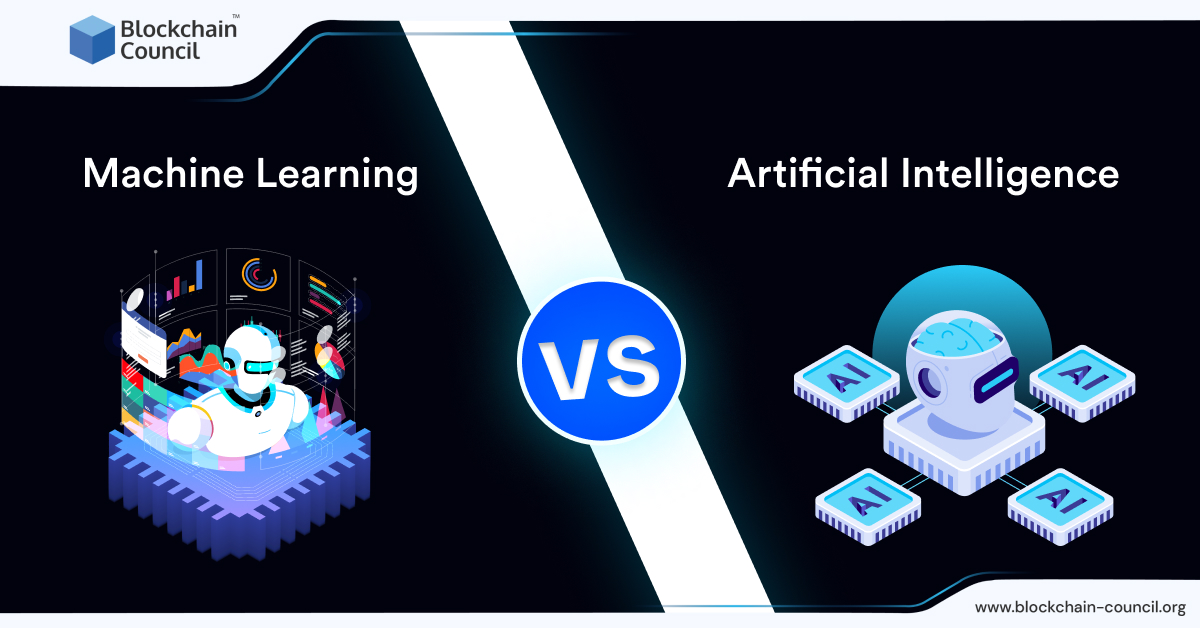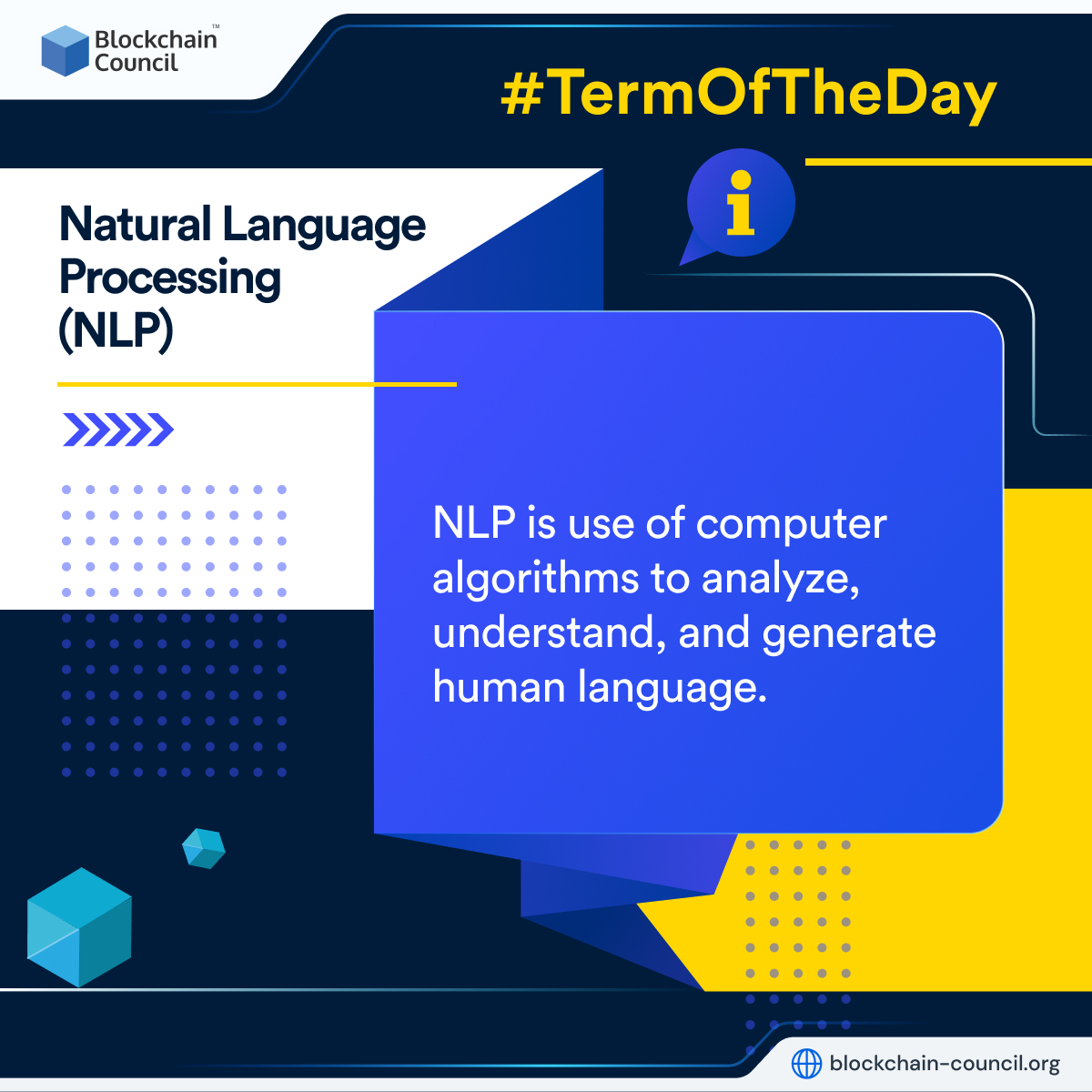
- Blockchain Council
- September 17, 2024
Summary
- The terms machine learning (ML) and artificial intelligence (AI) are often used interchangeably, but they have essential differences.
- AI refers to machines that can think and reason like humans, while machine learning is a subset of AI that focuses on machines learning from data without being explicitly programmed.
- The three main types of machine learning are supervised learning, unsupervised learning, and reinforcement learning.
- Machine learning is used in various applications, including predictive analytics, natural language processing, computer vision, fraud detection, and healthcare.The terms machine learning (ML) and artificial intelligence (AI) are often used interchangeably, but they have essential differences.
- AI aims to create machines that can perform tasks that would typically require human intelligence, such as recognizing speech and making decisions.
- There are four main types of AI: reactive machines, limited memory, theory of mind, and self-aware AI.
- AI is used in various applications, including personalized marketing, chatbots, autonomous vehicles, fraud detection, and healthcare.
- Key differences between machine learning and artificial intelligence include their scope, learning requirements, goals, and programming.
- Understanding these differences is crucial for anyone who wants to leverage the power of these technologies.
Introduction
In recent years, the terms machine learning (ML) and artificial intelligence (AI) have become ubiquitous in the technology industry. While they are often used interchangeably, there are essential differences between the two concepts. Understanding these differences is crucial for anyone who wants to leverage the power of these technologies.
AI refers to the broader concept of machines that can think and reason like humans. It encompasses a range of technologies, including natural language processing, computer vision, and robotics. On the other hand, machine learning is a subset of AI that focuses on the ability of machines to learn from data and improve their performance over time without being explicitly programmed.
This article will delve deeper into the differences between AI and machine learning, explore their uses, and highlight their benefits. It will also provide examples of how these technologies are being applied in real-world scenarios to help you understand their practical applications.
Understanding Machine Learning
Machine learning (ML) is a branch of artificial intelligence (AI) that involves teaching machines to learn from data and improve their performance over time without being explicitly programmed. It uses statistical and mathematical algorithms to identify patterns in data and make predictions or decisions based on those patterns. The goal of machine learning is to enable machines to learn from experience, just like humans do.
There are three main types of machine learning:
- Supervised Learning: This type of machine learning involves training the machine using labeled data, where the correct output is already known. The machine learns to identify patterns in the data and make predictions based on those patterns. Examples of supervised learning include image recognition, speech recognition, and natural language processing.
- Unsupervised Learning: In this type of machine learning, the machine is trained on unlabeled data, where the correct output is not known. The machine learns to identify patterns in the data without any guidance and can be used for tasks such as clustering and anomaly detection.
- Reinforcement Learning: This type of machine learning involves training the machine using a system of rewards and punishments. The machine learns to make decisions based on its environment and the feedback it receives to maximize its rewards. Reinforcement learning is often used in robotics and game development.
Applications of Machine Learning:
Machine learning is being used in a wide range of applications across industries. Some of the most common applications of machine learning include the following:
- Predictive Analytics: Machine learning is used to predict future outcomes based on past data. This is commonly used in finance, marketing, and healthcare.
- Natural Language Processing: Machine learning is used to analyze and understand human language. This is used in chatbots, voice assistants, and text analysis.
- Computer Vision: Machine learning is used to analyze and interpret images and videos. This is used in facial recognition, object detection, and autonomous vehicles.
- Fraud Detection: Machine learning is used to detect fraudulent transactions and activities in industries such as banking and insurance.
- Healthcare: Machine learning is used to diagnose diseases, identify potential health risks, and develop personalized treatment plans.
Understanding Artificial Intelligence
Artificial intelligence (AI) is a broad field of computer science and engineering that aims to create machines that can perform tasks that would normally require human intelligence, such as recognizing speech, understanding natural language, and making decisions. AI is based on the idea that machines can learn from experience, just like humans, and can adapt to new situations and tasks.
There are four main types of artificial intelligence:
- Reactive Machines: These are the simplest type of AI, which can only react to specific situations based on pre-programmed rules. They cannot learn from experience and cannot use past data to improve their performance.
- Limited Memory: These AI systems can store and use past experiences to improve their performance, but only in a limited way. Examples of limited memory AI include self-driving cars and facial recognition systems.
- Theory of Mind: This is an advanced type of AI that can understand the emotions and intentions of other people and can use that information to make decisions. It is still largely in the research stage and is not widely used yet.
- Self-Aware AI: This is the most advanced type of AI, which has a sense of self-awareness and can think and reason like humans. This type of AI does not exist yet and is largely the subject of science fiction.
Applications of Artificial Intelligence
AI is being used in a wide range of applications across industries. Some of the most common applications of AI include:
- Personalized Marketing: AI is used to analyze customer data and provide personalized recommendations and offers.
- Chatbots: AI chatbots can answer customer queries and provide assistance and are now used across numerous domains and industries.
- Autonomous Vehicles: AI is used to power self-driving cars, which can make decisions based on their environment and traffic conditions.
- Fraud Detection: AI is used to detect fraudulent activities and transactions in industries such as banking and insurance.
- Healthcare: AI is used to analyze medical data and provide personalized treatment plans.
Also Read: Discussion ChatGPT its impact on Blockchain and Web3 space
Differences between Machine Learning and Artificial Intelligence
Key differences between the two technologies
Although machine learning (ML) and artificial intelligence (AI) are closely related, there are some key differences between the two technologies:
- Scope: Machine learning is a subset of AI. While AI focuses on creating machines that can simulate human intelligence, machine learning specifically focuses on creating algorithms that can learn from data.
- Learning: Machine learning algorithms require large amounts of data to learn and improve their performance over time. Artificial intelligence, on the other hand, may not necessarily require data to function.
- Goal: The ultimate goal of machine learning is to create algorithms that can make predictions or decisions based on patterns in data. The goal of artificial intelligence is to create machines that can simulate human intelligence and perform tasks that normally require human cognition.
- Programming: Machine learning algorithms are explicitly programmed to learn from data, whereas artificial intelligence systems are programmed to perform tasks without necessarily learning from data.
Use cases where one technology is preferred over the other
When to use Machine Learning?
Machine learning is preferred when the focus is on making predictions or decisions based on patterns in data. For example, machine learning algorithms can be used for fraud detection in finance, personalized recommendations in e-commerce, and predicting customer churn in telecommunications.
When to use Artificial Intelligence?
Artificial intelligence is preferred when the focus is on creating machines that can simulate human intelligence and perform tasks that require human cognition. For example, artificial intelligence can be used for autonomous vehicles, speech recognition, and natural language processing.
Overall, both machine learning and artificial intelligence are important technologies with a wide range of applications. The choice between the two technologies depends on the specific use case and the goals of the project. In some cases, both technologies may be used together to create more powerful solutions.
Benefits of Machine Learning and Artificial Intelligence
Improved accuracy and efficiency in decision-making:
Both machine learning and artificial intelligence algorithms can analyze vast amounts of data quickly and accurately, allowing organizations to make better decisions. For example, machine learning algorithms can predict which customers are most likely to churn, allowing organizations to proactively retain those customers. Artificial intelligence can be used to analyze data from medical tests and help doctors make more accurate diagnoses.
Enhanced customer experience:
Both technologies can be used to create personalized customer experiences. For example, e-commerce companies can use machine learning algorithms to provide personalized product recommendations based on a customer’s browsing and purchasing history. Chatbots powered by artificial intelligence can provide fast and efficient customer service 24/7, improving the overall customer experience.
Automation of tedious and repetitive tasks:
Both of them can automate tedious and repetitive tasks, freeing up employees to focus on more strategic work. For example, machine learning algorithms can automatically categorize and tag images, saving photographers hours of manual work. Artificial intelligence can be used to automate routine customer services tasks such as password resets and account balance inquiries.
Reduced operational costs:
Last but not least, both machine learning and artificial intelligence can help organizations reduce operational costs by improving efficiency and reducing waste. For example, machine learning algorithms can optimize supply chain operations, reducing inventory carrying costs and improving delivery times. Artificial intelligence can be used to detect and prevent fraudulent activities, reducing losses due to fraud.
Future of Machine Learning and Artificial Intelligence
Advancements in Natural Language Processing (NLP):
NLP is a subfield of artificial intelligence that focuses on understanding human language. Recent advancements in NLP have led to the development of language models such as GPT-3, which can generate human-like text. These models have a wide range of applications, from chatbots to language translation.
Increased use of Deep Learning:
Deep learning is a subset of machine learning that uses neural networks to model complex patterns in data. Deep learning has been used to achieve breakthroughs in fields such as image recognition, speech recognition, and natural language processing. As more data becomes available, deep learning is expected to become even more powerful.
Integration of Machine Learning and IoT:
The Internet of Things (IoT) is a network of connected devices that can collect and exchange data. Machine learning algorithms can be used to analyze this data and make predictions about future events. This integration is expected to lead to the development of smart cities, where traffic flow, energy consumption, and other factors are optimized in real-time.
Ethical Considerations:
As machine learning and artificial intelligence become more prevalent, there is increasing concern about the ethical implications of these technologies. Issues such as bias in algorithms, data privacy, and job displacement will need to be addressed to ensure that these technologies are used responsibly and ethically.
The future of machine learning and artificial intelligence is expected to be transformative, with these technologies driving innovation across industries. Predictions for the future impact of these technologies include increased automation, improved decision-making, and enhanced customer experiences. However, it will be important to address ethical concerns and ensure that these technologies are used in a way that benefits society as a whole.
Conclusion
This article has discussed the definitions, types, and applications of machine learning and artificial intelligence, as well as the key differences between the two technologies. It has also highlighted the benefits of these technologies, including improved decision-making, enhanced customer experiences, automation of tedious tasks, and reduced operational costs.
Looking ahead, the article has explored some of the emerging trends in the field of machine learning and artificial intelligence, including advancements in natural language processing, increased use of deep learning, integration with the Internet of Things, and ethical considerations.
The significance of machine learning and artificial intelligence cannot be overstated. These technologies have already transformed industries such as healthcare, finance, and manufacturing, and they are expected to continue to drive innovation and economic growth in the coming years.
However, it is important to remember that with great power comes great responsibility. As these technologies become more prevalent, addressing ethical concerns and ensuring that they are used responsibly and ethically is crucial. Only then we will fully realize the potential of machine learning and artificial intelligence to improve our lives and create a better future for all.
Frequently Asked Questions
What is the difference between machine learning and artificial intelligence?
Machine learning is a subset of AI that involves training algorithms to make predictions or decisions based on data. Artificial intelligence is a broader term that encompasses any technology that can perform tasks that typically require human intelligence, such as speech recognition, decision-making, and natural language processing.
What are some common applications of machine learning and artificial intelligence?
Machine learning and artificial intelligence have a wide range of applications, including image recognition, natural language processing, fraud detection, predictive maintenance, and personalized marketing.
What are the benefits of machine learning and artificial intelligence?
The benefits of machine learning and artificial intelligence include improved decision-making, enhanced customer experiences, automation of tedious tasks, and reduced operational costs.
How will machine learning and artificial intelligence impact the job market?
While machine learning and artificial intelligence have the potential to automate many jobs, they will also create new jobs in fields such as data science, machine learning engineering, and artificial intelligence ethics. It is important for workers to adapt and develop new skills to stay competitive in the job market.






































































 Guides
Guides News
News Blockchain
Blockchain Cryptocurrency
& Digital Assets
Cryptocurrency
& Digital Assets Web3
Web3 Metaverse & NFTs
Metaverse & NFTs
